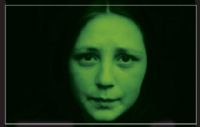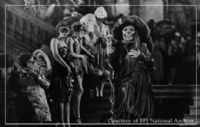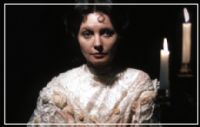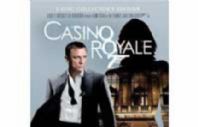Lon Chaney's Phantom Returns...
Date: 29/11/2013
DVD Review
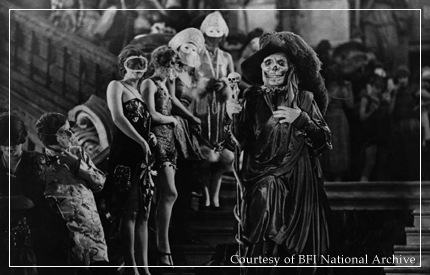
The BFI rounds off its 'GOTHIC: The Dark Heart of Film' season with the release of a newly-restored Blu Ray and DVD print of Julian Rupert's macabre romance; The Phantom Of The Opera.
Starring Lon Chaney, this 1925 adaptation of Gaston Leroux's famous Gothic tragedy is a masterpiece in expressionist horror, presented here fully restored and with a score composed by Carl Davis.
Christine Daaé, played by Mary Philbin, is an operatic understudy who finds herself performing the lead role in Gounod's Faust at the famous Paris Opera House, under the behest of a mysterious unseen figure known only as 'The Phantom'.
Christine's anonymous admirer has been sabotaging the career of the prima donna, Carlotta, so that she might become a star and be worshipped by all of Paris. The Phantom does this, he tells her, in exchange for her love and utter subservience to him. Cast under his spell and the promises of fame and glory, Christine calls off her relationship with the Vicomte Raoul de Chagny, played by Norman Kerry, and decides to devote herself to her unknown 'Master'.
But when the mysterious, masked figure brings her to his abode, through the labyrinthine corridors deep underneath the Opera House, Christine comes face to face with the deformed Phantom for the first time, and begs her lover Raoul to rescue her from the spectre's clutches...
The Phantom Of The Opera is one of the most celebrated titles produced during Universal Studio's golden age of monster movies. As a product of the silent era, the film dwells heavily on visual effects to create terror and a sense of Gothic macabre.
This is particularly evident in the case of the two stars, Chaney and Philbin. Chaney was the son of two deaf mutes, and his mastery of hand movements and facial expressions communicates perfectly the turmoil of his character throughout the film.
Philbin plays the typical silent era heroine, recoiling in terror when faced with the newly-unmasked Phantom for the first time, and performs perhaps the most energetic and physically demanding role of all the cast.
At its core, The Phantom Of The Opera, is a visual nightmare, taking its cue undoubtedly from the German Expressionist cinema that preceded it, such as Robert Wiene's The Cabinet of Dr. Caligari (1919). The German influence is certainly appropriate, given the heavy Goethean undercurrent within the storyline.
Christine's role in the opera is Marguerite; a young woman seduced by the character Faust after he sells his soul to Mephistopheles, who is the devil-incarnate. This Faustian idea of selling one's soul to the devil mirrors Christine's own actions, as she ultimately serves up her freedom to the Phantom in exchange for an illustrious career. Only when it is too late will the singer come to realise the hastiness with which she bartered her life.
Rupert Julian's film is heavily stylised, and modern audiences will note the rigour and physical strain placed under the actors, as they seek to convey their emotions in actions and facial expressions, rather than words. This lends The Phantom Of The Opera a theatrical, expressive quality that adds to the majestic feel of the film's aesthetic.
The depiction of ballerinas and the Phantom's cavernous abode, the stark contrast between light and shade and the overall visual effect of the picture were clearly a heavy influence on Dario Argento's psychedelic nightmare, Suspiria (1977). The Italian horror maestro was certainly interested in the story of a cursed Opera House, as he would visit it twice during his career; in 1987's theatrical giallo Opera and his eventual adaptation of the Gaston Leroux novel with Phantom Of The Opera, in 1998.
The sets and layout of the operatic backdrop are cinematic feats in themselves, and were designed by Ben Carré, who had previously worked in the Paris Opera and was, consequentially, able to lend them an air of authenticity. In fact, when Andrew Lloyd-Webber was designing the set for his stage production of Phantom, he and his crew returned to Carré's original sketches for inspiration. When the production debuted at Her Majesty's Theatre in London, Lloyd-Webber tellingly invited Carré's widow along to the opening night.
One of the most celebrated sequences in the film is when Chaney's Phantom interrupts the annual masquerade ball dressed all in red, save for a skull mask covering his face. The sequence was filmed in Technicolor for top general release; hence the multicoloured nature of the revellers' costumes and the Phantom's blood-red gown.
It is during this sequence that the Phantom follows Christine and Raoul to the top of the Opera House and overhears her betrayal of him to the Vicomte, thus evoking the monster's rage and precipitating the conclusion of the storyline.
As is to be expected, the ultimate, lasting feeling following the film's abrupt closure, as the Phantom is ripped apart by a torch-bearing mob and flung into the Seine, is that of pity. The story depicts, perhaps more than anything else, the nature of 'evil' as a social construct; something born out of condition, rather than predilection.
The Phantom is ultimately banished to his underground layer as a result of an image-conscious world and, as can be seen so often in reality, individuals scorned by society have little reason to respect it. While the abruptness of the story's closure might seem underworked to modern audiences, it nevertheless provides a startling tableau of the tragedy of human existence, and the ultimate, tortured futility of unrequited love.
Iain Todd
The BFI releases Rupert Julian's The Phantom Of The Opera on Blu Ray and DVD on 2 December.
Starring Lon Chaney, this 1925 adaptation of Gaston Leroux's famous Gothic tragedy is a masterpiece in expressionist horror, presented here fully restored and with a score composed by Carl Davis.
Christine Daaé, played by Mary Philbin, is an operatic understudy who finds herself performing the lead role in Gounod's Faust at the famous Paris Opera House, under the behest of a mysterious unseen figure known only as 'The Phantom'.
Christine's anonymous admirer has been sabotaging the career of the prima donna, Carlotta, so that she might become a star and be worshipped by all of Paris. The Phantom does this, he tells her, in exchange for her love and utter subservience to him. Cast under his spell and the promises of fame and glory, Christine calls off her relationship with the Vicomte Raoul de Chagny, played by Norman Kerry, and decides to devote herself to her unknown 'Master'.
But when the mysterious, masked figure brings her to his abode, through the labyrinthine corridors deep underneath the Opera House, Christine comes face to face with the deformed Phantom for the first time, and begs her lover Raoul to rescue her from the spectre's clutches...
The Phantom Of The Opera is one of the most celebrated titles produced during Universal Studio's golden age of monster movies. As a product of the silent era, the film dwells heavily on visual effects to create terror and a sense of Gothic macabre.
This is particularly evident in the case of the two stars, Chaney and Philbin. Chaney was the son of two deaf mutes, and his mastery of hand movements and facial expressions communicates perfectly the turmoil of his character throughout the film.
Philbin plays the typical silent era heroine, recoiling in terror when faced with the newly-unmasked Phantom for the first time, and performs perhaps the most energetic and physically demanding role of all the cast.
At its core, The Phantom Of The Opera, is a visual nightmare, taking its cue undoubtedly from the German Expressionist cinema that preceded it, such as Robert Wiene's The Cabinet of Dr. Caligari (1919). The German influence is certainly appropriate, given the heavy Goethean undercurrent within the storyline.
Christine's role in the opera is Marguerite; a young woman seduced by the character Faust after he sells his soul to Mephistopheles, who is the devil-incarnate. This Faustian idea of selling one's soul to the devil mirrors Christine's own actions, as she ultimately serves up her freedom to the Phantom in exchange for an illustrious career. Only when it is too late will the singer come to realise the hastiness with which she bartered her life.
Rupert Julian's film is heavily stylised, and modern audiences will note the rigour and physical strain placed under the actors, as they seek to convey their emotions in actions and facial expressions, rather than words. This lends The Phantom Of The Opera a theatrical, expressive quality that adds to the majestic feel of the film's aesthetic.
The depiction of ballerinas and the Phantom's cavernous abode, the stark contrast between light and shade and the overall visual effect of the picture were clearly a heavy influence on Dario Argento's psychedelic nightmare, Suspiria (1977). The Italian horror maestro was certainly interested in the story of a cursed Opera House, as he would visit it twice during his career; in 1987's theatrical giallo Opera and his eventual adaptation of the Gaston Leroux novel with Phantom Of The Opera, in 1998.
The sets and layout of the operatic backdrop are cinematic feats in themselves, and were designed by Ben Carré, who had previously worked in the Paris Opera and was, consequentially, able to lend them an air of authenticity. In fact, when Andrew Lloyd-Webber was designing the set for his stage production of Phantom, he and his crew returned to Carré's original sketches for inspiration. When the production debuted at Her Majesty's Theatre in London, Lloyd-Webber tellingly invited Carré's widow along to the opening night.
One of the most celebrated sequences in the film is when Chaney's Phantom interrupts the annual masquerade ball dressed all in red, save for a skull mask covering his face. The sequence was filmed in Technicolor for top general release; hence the multicoloured nature of the revellers' costumes and the Phantom's blood-red gown.
It is during this sequence that the Phantom follows Christine and Raoul to the top of the Opera House and overhears her betrayal of him to the Vicomte, thus evoking the monster's rage and precipitating the conclusion of the storyline.
As is to be expected, the ultimate, lasting feeling following the film's abrupt closure, as the Phantom is ripped apart by a torch-bearing mob and flung into the Seine, is that of pity. The story depicts, perhaps more than anything else, the nature of 'evil' as a social construct; something born out of condition, rather than predilection.
The Phantom is ultimately banished to his underground layer as a result of an image-conscious world and, as can be seen so often in reality, individuals scorned by society have little reason to respect it. While the abruptness of the story's closure might seem underworked to modern audiences, it nevertheless provides a startling tableau of the tragedy of human existence, and the ultimate, tortured futility of unrequited love.
Iain Todd
The BFI releases Rupert Julian's The Phantom Of The Opera on Blu Ray and DVD on 2 December.
More info : http://www.bfi.org.uk/gothic


























